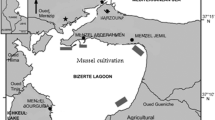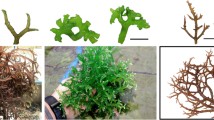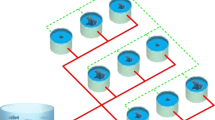Abstract
Intensive fish aquaculture activities release large amount of nitrogen (NH4-N and NO3-N) to the surrounding waters and lead to water eutrophication. However, integrating a single species of seaweed with the fed fish usually cannot remove both forms of nitrogen efficiently. Polyculture of different seaweeds will be an effective way to reduce the nitrogen load of surrounding waters. To compare the feasibility of using Caulerpa lentillifera and Gracilaria lichenoides as biofilters to treat marine fish aquaculture effluents, nine NH4-N/NO3-N ratios were set up and the nitrogen uptake and growth rate of the two seaweeds were measured. The main results showed that: (1) In the presence of multiple N sources, C. lentillifera selectively takes up NO3-N prior to NH4-N and the NO3-N uptake rate was 7.43–50.43 μmol g−1 (dw) h−1 which was significantly higher than that of G. lichenoides. Gracilaria lichenoides selectively takes up NH4-N prior to NO3-N and the NH4-N uptake rate was 10.27–14.14 μmol g−1 (dw) h−1 which was significantly higher than that of C. lentillifera. (2) The NH4-N/NO3-N ratio had effects on the growth of the two seaweeds: 1/1 and 1/5 of NH4-N/NO3-N were favorable for the growth of C. lentillifera; 1/4 and 1/0.5 of NH4-N/NO3-N were favorable for the growth of G. lichenoides. The results preliminarily indicate that integrated culture of C. lentillifera and G. lichenoides was sufficient for bioremediation of marine fish aquaculture effluents.


Similar content being viewed by others
References
Ale MT, Mikkelsen JD, Meyer AS (2011) Differential growth response of Ulva lactuca to ammonium and nitrate assimilation. J Appl Phycol 23:345–351
Apiratikul R, Pavasant P (2008) Batch and column studies of biosorption of heavy metals by Caulerpa lentillifera. BioresourTechnol 99:2766–2777
Bracken ME, Stachowicz JJ (2006) Seaweed diversity enhances nitrogen uptake via complementary use of nitrate and ammonium. Ecology 87:2397–2403
Burgin AJ, Yang WH, Hamilton SK, Silver WL (2011) Beyond carbon and nitrogen: how the microbial energy economy couples elemental cycles in diverse ecosystems. Front Ecol Environ 9:44–52
Cahill PL, Hurd CL, Lokman M (2010) Keeping the water clean-seaweed biofiltration outperforms traditional bacterial biofilms in recirculating aquaculture. Aquaculture 306:153–159
Castine SA, McKinnon AD, Paul NA, Trott LA, de Nys R (2013) Wastewater treatment for land-based aquaculture: improvements and value-adding alternatives in model systems from Australia. Aquac Environ Interact 4:285–300
Chopin T, Buschmann AH, Halling C, Troell M, Kautsky N, Neori A, Neefus C (2001) Integrating seaweeds into marine aquaculture systems: a key toward sustainability. J Phycol 37:975–986
Chung IK, Kang YH, Yarish C, Kraemer GP, Lee JA (2002) Application of seaweed cultivation to the bioremediation of nutrient-rich effluent. Algae 17:187–194
Cohen RA, Fong P (2004) Nitrogen uptake and assimilation in Enteromorpha intestinalis (L.) Link (Chlorophyta): using 15N to determine preference during simultaneous pulses of nitrate and ammonium. J Exp Mar Biol Ecol 309:67–77
Friedlander M, Levy I (1995) Cultivation of Gracilaria in outdoor tanks and ponds. J Appl Phycol 7:315–324
Guo H, Yao J, Sun Z, Duan D (2015) Effects of salinity and nutrients on the growth and chlorophyll fluorescence of Caulerpa lentillifera. Chin J Oceanol Limnol 33:410–418
He P, Xu S, Zhang H, Wen S, Dai Y, Lin S, Yarish C (2008) Bioremediation efficiency in the removal of dissolved inorganic nutrients by the red seaweed, Porphyra yezoensis, cultivated in the open sea. Water Res 42:1281–1289
Hernández I, Martínez-Aragón JF, Tovar A, Pérez-Lloréns JL, Vergara JJ (2002) Biofiltering efficiency in removal of dissolved nutrients by three species of estuarine macroalgae cultivated with sea bass (Dicentrarchus labrax) waste waters 2. Ammonium. J Appl Phycol 14:375–384
Hooper DU, Chapin IFS, EwelJJ HA, Inchausti P, Lavorel S, Schmid B (2005) Effects of biodiversity on ecosystem functioning: a consensus of current knowledge. Ecol Monogr 75:3–35
Huang HZ, Sun JY, Shen H, Wang YL (2006) Effects of different inorganic nitrogen sources and concentrations on the growth and biochemical constituents of Gracilaria tenuistipitata var. liui Zhang et Xia. Mar Sci 30:23–27 (In Chinese)
Lan L (2013) Study on absorption, utilization and transformation of N of Grateloupia turuturu Yamada. Msc Thesis, Ocean University of China, China 97 pp
Lin YF, Jing SR, Lee DY (2003) The potential use of constructed wetlands in a recirculating aquaculture system for shrimp culture. Environ Pollut 123:107–113
Lobban CS, Harrison PJ (1994) Seaweed ecology and physiology. Cambridge University Press, England
Loreau M, Naeem S, Inchausti P, Bengtsson J, Grime JP, Hector A, Tilman D (2001) Biodiversity and ecosystem functioning: current knowledge and future challenges. Science 294:804–808
Luo MB, Liu F, Xu ZL (2012) Growth and nutrient uptake capacity of two co-occurring species, Ulva prolifera and Ulva linza. Aquat Bot 100:18–24
Marinho-Soriano E, Nunes SO, Carneiro MAA, Pereira DC (2009) Nutrients’ removal from aquaculture wastewater using the macroalgae Gracilaria birdiae. Biomass Bioenerg 33:327–331
Marungrueng K, Pavasant P (2006) Removal of basic dye (astrazon blue FGRL) using macroalga Caulerpa lentillifera. J Environ Manag 78:268–274
Matos J, Costa S, Rodrigues A, Pereira R, Pinto IS (2006) Experimental integrated aquaculture of fish and red seaweeds in Northern Portugal. Aquaculture 252:31–42
Metaxa E, Deviller G, Pagand P, Alliaume C, Casellas C, Blancheton JP (2006) High rate algal pond treatment for water reuse in a marine fish recirculation system: water purification and fish health. Aquaculture 252:92–101
Naldi M, Wheeler PA (1999) Changes in nitrogen pools in Ulva fenestrata (Chlorophyta) and Gracilaria pacifica (Rhodophyta) under nitrate and ammonium enrichment. J Phycol 35:70–77
Neori A, Cohen I, Gordin H (1991) Ulva lactuca biofilters for marine fishpond effluents. II. Growth rate, yield and C: N ratio. Bot Mar 34:483–490
Neori A, Krom MD, Ellner SP, Boyd CE, Popper D, Rabinovitch R, Angel D (1996) Seaweed biofilters as regulators of water quality in integrated fish-seaweed culture units. Aquaculture 141:183–199
Neori A, Chopin T, Troell M, Buschmann AH, Kraemer GP, Halling C, Yarish C (2004) Integrated aquaculture: rationale, evolution and state of the art emphasizing seaweed biofiltration in modern mariculture. Aquaculture 231:361–391
Nirmal Kumar JI, Chakraborty S, Kumar RN, Amb MK, Bora A (2010) Enzymatic variations among different species of marine macroalgae from Okha Port, Gulf of Kutch, India. Int J Biotechnol Biochem 6:889–899
Pariyawathee S, Songsangjinda P, Deraxbudsarakom S, Tuntichodok P, Chiayvareesajja S (2003) Optimum condition of environmental factors for growth of sea grape (Caulerpa lentillifera: J. Agardh). Thai Fish Gaz 56:443–448 (In Thai)
Paul NA, De Nys R (2008) Promise and pitfalls of locally abundant seaweeds as biofilters for integrated aquaculture. Aquaculture 281:49–55
Paul NA, Neveux N, Magnusson M, De Nys R (2014) Comparative production and nutritional value of “sea grapes”—the tropical green seaweeds Caulerpa lentillifera and C. racemosa. J Appl Phycol 26:1833–1844
Pavasant P, Apiratikul R, Sungkhum V, Suthiparinyanont P, Wattanachira S, Marhaba TF (2006) Biosorption of Cu2+, Cd2+, Pb2+ and Zn2+ using dried marine green macroalga Caulerpa lentillifera. Bioresour Technol 97:2321–2329
Pedersen MF (1994) Transient ammonium uptake in the macroalga Ulva lactuca (Chlorophyta): nature, regulation and the consequences for choice of measuring technique. J Phycol 30:980–986
Piedrahita RH (2003) Reducing the potential environmental impact of tank aquaculture effluents through intensification and recirculation. Aquaculture 226:35–44
Ryther JH, Corwin N, DeBusk TA, Williams LD (1981) Nitrogen uptake and storage by the red alga Gracilaria tikvahiae (McLachlan, 1979). Aquaculture 26:107–115
Sikora FJ, Tong Z, Behrends LL, Steinberg SL, Coonrod HS (1995) Ammonium removal in constructed wetlands with recirculating subsurface flow: removal rates and mechanisms. Water Sci Technol 32:193–202
Stachowicz JJ, Graham M, Bracken ME, Szoboszlai AI (2008) Diversity enhances cover and stability of seaweed assemblages: the role of heterogeneity and time. Ecology 89:3008–3019
Teichberg M, Fox SE, Aguila C, Olsen YS, Valiela I (2008) Macroalgal responses to experimental nutrient enrichment in shallow coastal waters: growth, internal nutrient pools, and isotopic signatures. Mar Ecol Prog Ser 368:117–126
Thomas TE, Harrison PJ (1985) Effect of nitrogen supply on nitrogen uptake, accumulation and assimilation in Porphyra perforata (Rhodophyta). Mar Biol 85:269–278
Tilman D, Wedin D, Knops J (1996) Productivity and sustainability influenced by biodiversity in grassland ecosystems. Nature 379:718–720
Xu ZG, Zou DH (2008) Effects of increased atmospheric CO2 and N supply on growth, biochemical compositions and uptake of nutrients in Gracilaria lemaneiformis (Rhodophyta). Acta Ecol Sin 28:3752–3759
Xu Z, Lin X, Lin J, Xie L, Huang C (2001) The effects of nutrient availability on the uptake of nitrogen and phosphorus by Gracilaria tenuistipitata var. liui Zhang et Xia. Acta Ecol Sin 22:366–374
Yang Y, Chai Z, Wang Q, Chen W, He Z, Jiang S (2015) Cultivation of seaweed Gracilaria in Chinese coastal waters and its contribution to environmental improvements. Algal Res 9:236–244
Yong YS, Yong WTL, Anton A (2013) Analysis of formulae for determination of seaweed growth rate. J Appl Phycol 25:1831–1834
Acknowledgments
We thank all members of Ecology Lab for practical assistance and technical support. We also thank Dr. L Li for the English review of this paper. This study was supported by the Major Project for Agricultural Application Technology Innovation of Shandong Province (Grant No. 2013–136) and Function Laboratory for Marine Fisheries Science and Food Production Processes, Qingdao National Laboratory for Marine Science and Technology.
Author information
Authors and Affiliations
Corresponding authors
Rights and permissions
About this article
Cite this article
Liu, H., Wang, F., Wang, Q. et al. A comparative study of the nutrient uptake and growth capacities of seaweeds Caulerpa lentillifera and Gracilaria lichenoides . J Appl Phycol 28, 3083–3089 (2016). https://doi.org/10.1007/s10811-016-0858-8
Received:
Revised:
Accepted:
Published:
Issue Date:
DOI: https://doi.org/10.1007/s10811-016-0858-8




